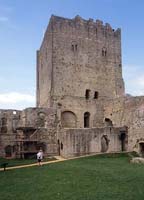| |
 |
Portchester Portchester Castle |
Portchester Castle is situated on a low-lying promontory overlooking Portsmouth Harbour and has formed part of the Portsmouth fortifications since the Norman period.
The Normans were not the first to recognise the importance of the site, for in the 3rd century AD the Romans built a base there for the Roman fleet. The Channel needed to be cleared of barbarian raiders and Carausius was charged with this task. He was probably responsible for the construction of the fort which enclosed an area of 3.5ha (8.5 acres), with defensive walls 3m (10 feet) wide and about 6.1m (20 feet) high, surrounded by a double ditch. These walls survive today, are built of coursed flint work with horizontal bonding courses of tile, and the upper parts are medieval.
When the Normans arrived they too recognised the fort's key position, and built the castle and priory there. The castle was built in the north-west corner of the Roman fort in the 12th century, probably during the reign of Henry I (1100-35).
A keep was built with a series of floors accessed by a spiral staircase. The walled inner bailey had ranges of buildings, including chambers, a kitchen, stores and a chapel. These were defended by a curtain wall and surrounding moat. A gatehouse controlled the drawbridge over the moat dividing it from the outer bailey.
The castle was modified many times in its history, serving as a residence for royal visits and a store. It was particularly important during the Hundred Years' War, but during the 16-17th centuries, following the development of new defences in the region, its strategic role faded. Today you can see a mixture of architectural forms, but the Norman keep remains much as it was in the 12th century.
Bibliography
Cunliffe, B.W., 1977. Excavations at Portchester Castle 3: Medieval, the outer bailey and its defences, Society of Antiquaries of London Research Report (London)
Munby, J.T., 2000. Portchester Castle (English Heritage)
Pevsner, N., and Lloyd, D., 1990. The Buildings of England, Hampshire and the Isle of Wight (London, Penguin), 377-82